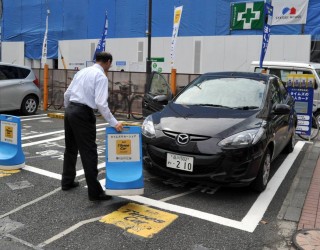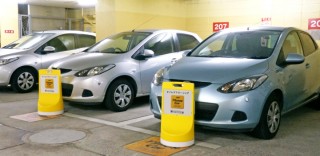Loading
Search
▼ Car sharing: A cheaper alternative to owning a car in the city
- Category:Other

JAPANTIMES.co.jp
Owning a car in Japan can be a hassle if you live in a city because it often comes with the extra cost of renting a parking space.
That partly explains the rising popularity of car sharing. Many people have come to see it as not only cheaper but also more practical than owning an automobile. Here are some questions and answers about car sharing in this country:
Is car sharing on the rise?
The number of people registering for car sharing services is increasing. The total was 465,280 in January, compared with 6,396 in the same month in 2009.
Also, the number of vehicles used for car sharing has jumped to 12,373 from 563 in the same period, according to the Foundation for Promoting Personal Mobility and Ecological Transportation, known more commonly as Eco-Mo Foundation, a Tokyo-based group that promotes car sharing.
The figures have gone up in recent years with the entry of several private companies into the market.
Tokyo-based Park24 Co. launched its Times Car Plus business in 2009 and is now the nation’s biggest player, with about 400,000 registered users.

Its core business remains the operation of about 14,000 parking garages across the country, but it has enjoyed synergy between the two enterprises.
Why is it popular?
By its nature, the concept meets many people’s needs. Shinji Kato, general manager of the division that promotes environmentally aware transport at the Eco-Mo Foundation, said city residents can save money.
“Car sharing is growing in busy, densely populated cities that have convenient public transportation systems and in which people don’t drive frequently,” Kato said.
Car owners are required to show that they have space for the car. If a recognized parking space doesn’t come with their apartment or house, they have to rent one. A parking spot can cost ¥30,000 to ¥50,000 per month in central Tokyo.
With car sharing, drivers can not only save on parking fees but also on insurance and other car-related taxes. When they want to drive, they can simply make a reservation online and walk to the nearest car sharing station.
How much does it cost to use car sharing services?
It depends on the company, but rentals typically range from ¥200 to ¥300 per 15 minutes, plus a monthly registration fee.
For instance, Park24 charges ¥206 for every 15 minutes, which includes gas and insurance fees. It charges a one-time registration fee of ¥1,550 and a monthly fee of ¥1,030 thereafter.
Orix Auto Corp., the second-biggest operator, has two plans. One charges ¥2,000 per month and ¥200 for 15 minutes of use, with an additional charge of ¥15 per kilometer driven. The other plan has no standing monthly fee but usage is priced at ¥300 for 15 minutes, plus ¥15 per kilometer driven.
For instance, Park24′s calculation shows that if a user takes a car twice a week for an hour each time, it will cost about ¥6,600 a month.
How is it different from renting a car?
Rental is suited for those who want to use a car for a longer period, such as a day or a few days, while car sharing is best for short-term use, said Tomoya Watanabe, a spokesman for Park24.
He said taking the rental route works out cheaper if a car is to be used for more than 10 hours at a time.
Also, renters can return their vehicle at a different location, a convenience that is not currently available for car sharers. But the government relaxed regulations in September, allowing car sharing service providers to offer it.
Does the public sector offer car sharing services?
Many municipalities provide a service or have tried it in the past in collaboration with private-sector firms so they can share their official vehicle fleet.
“We use our public cars on weekdays, but they are not in use at night and on weekends. We started a car sharing service to use them more effectively,” said Akira Idemoto, director of the building and repairs section in the Minoh Municipal Government in Osaka Prefecture.
He added that another reason for promoting shared use of cars is that it may help the environment by reducing overall carbon dioxide emissions.
Yet Idemoto said Minoh residents have given a muted reaction so far and only 180 of the city’s 130,000 residents have registered for the service.
He said there is little incentive because most households own a car and tend to drive regularly because of the area’s limited local provision of public transportation.
What kind of cars can sharers expect to use?
Private-sector providers offer a wide variety of vehicle.
Park24 offers 22 kinds of cars under its standard plan, including Toyota’s hybrid Prius, Mitsubishi’s electric i-MiEV and Mazda’s Premacy minivan, which can accommodate seven people.
For a higher fee, sharers can pick up a BMW 116i, Volkswagen Golf or Audi A1.
The firm said what people choose varies according to the task in hand.
Is car sharing really better for the environment?
Eco-Mo Foundation conducted a survey that shows car sharing helps cut carbon dioxide emissions.
The survey was conducted on 491 people through car sharing service providers in 2012 and found that before they used car sharing services, each household drove an average of 4,048 km annually, but only 2,563 km after turning to car sharing.
Before they became users, 40.6 percent of the households said they owned at least one car, but the ratio fell to 13.2 percent after they started using the service. As a result, average carbon dioxide emissions per household decreased to 0.42 tons from 0.76 tons per year, according to Eco-Mo Foundation.
What is the future for the sector?
More people are signing up for the service, but car sharing has low recognition among the public at large, said Watanabe of Park24.
“I think the words ‘car sharing’ are widely recognized, but when you ask people if they know what it entails, many don’t,” said Watanabe, adding that the firm will keep increasing the number of vehicles for car sharing to make it more convenient for users.
Kato said what is needed is greater collaboration between car sharing providers and railway companies, so that rail users might one day step from the train and into a car.
- October 17, 2014
- Comment (0)
- Trackback(0)

